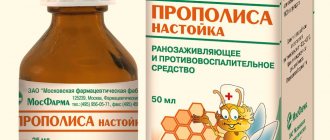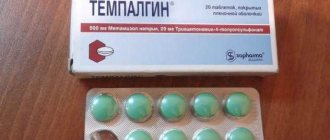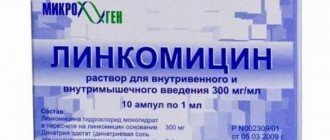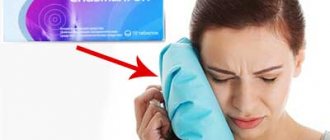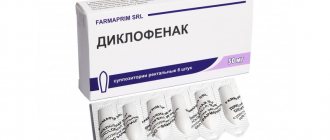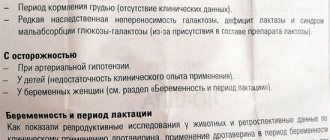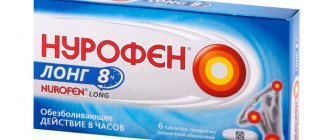Composition and pharmacological properties of the drug
The active ingredient of novocaine is procaine hydrochloride 10 mg in 2 ml or 25 mg in 5 ml of solution; Excipients: hydrochloric acid, water for injection.
Novocaine is a local anesthetic drug. Its action is based on disruption of the conduction of nerve impulses from the brain to the diseased area, as well as on reducing spasms of smooth muscles.
Reference! The effect of novocaine lasts for 0.5-1 hour. To prolong the analgesic effect, it is necessary to use the product in combination with adrenaline. With increasing concentration of solutions, it is recommended to reduce the total dose.
Toothache spray: composition, instructions for use and dosage
A substance called lidocaine is currently used in toothache sprays in dentistry. This component is a local anesthetic. Its effect lasts from thirty to seventy minutes.
In addition to it, our article will consider the Novocain spray, which is also used for toothache. But first, we will find out how to use Lidocaine spray to treat and eliminate tooth pain.
Compound
As already mentioned, the active ingredient in toothache sprays is lidocaine. This is a substance from the amide series that produces a pronounced membrane stabilizing effect, blocking the conduction of impulses along the nerve fiber. Additional ingredients in the form of propylene glycol, ethyl alcohol and mint leaf oil contribute to the best absorption and assimilation of the active component.
Mechanism of action
Experts note the effectiveness of lidocaine-based toothache sprays. The mechanism of their influence in this case is quite simple:
- The active component acts on impulses that stop passing through the nerves.
- The nervous system no longer receives signals, so the pain quickly passes.
Benefits of Lidocaine
The toothache spray described in the article is gradually replacing Novocain from dentistry, which is also used to reduce the pain effect. This is because it has a number of positive qualities:
- A successful combination of a high level of effectiveness with safety and speed of action. According to these criteria, Lidocaine is many times superior to other pharmacological drugs used for pain relief in the past.
- The duration of action of this product is one and a half hours. This is quite enough to eliminate the causes of sudden pain. In some situations, the effect of the drug can be reduced to half an hour, which depends on the individual characteristics of the body and the location of the source of pain, since these factors determine the rate of leaching of the active components from the tissues.
- The presence of budget variations of the drug, for example, a solution in ampoules is produced in an affordable price range, thanks to which absolutely anyone can buy it.
The solution, which is sold in carpules, can be used by specialists in dental treatment. This form makes it easier for dentists to administer anesthesia, and thin needles do not cause additional pain to the patient during injection.
Toothache spray with lidocaine is very convenient to use for one-time relief of acute pain and during treatment. At the same time, the product significantly reduces the risk of a gag reflex during various manipulations in the oral cavity. In addition, its use makes it possible to reduce pain from subsequent injections.
Disadvantages of lidocaine-based sprays
But the anesthetic spray for toothache “Lidocaine” also has a number of certain disadvantages. Let's look at them below:
- The inability to use it in certain forms during breastfeeding.
- The product, which comes in the form of a spray, can be quite expensive. This drug in carpules can also cost several times more than the solution sold in conventional ampoules.
- The presence of contraindications that could prevent this method of pain relief.
- There is a possibility that to purchase Lidocaine in pharmacies you will need a prescription, which must be written out by a specialist.
Before using ice-caine spray for toothache, you should read the instructions that come with the drug, and be sure to coordinate the use of this product with a specialist.
Strict compliance and adherence to all rules for the use of this product guarantees safety, minimizing the risk of serious side effects. Below we provide a list of basic rules that relate to the use of Lidocaine.
The proposed instructions are a simplified version of the main manual:
- The aerosol is sprayed directly onto the tooth or onto the inflamed area located in the oral cavity. The procedure is repeated every hour and a half; three dosages are allowed at a time. The daily norm cannot exceed twenty doses. The total duration of the effect of application, as a rule, does not exceed an hour.
- This drug can be used for pain relief during pregnancy, but the single dose should be significantly reduced. In any case, it will be necessary to coordinate this issue with a specialist, and, in addition, to obtain permission from him in the event that such measures turn out to be appropriate.
- Persons over sixty-five, as well as patients during rehabilitation and immediately after surgery, require a dose reduction.
- It is very important to comply with the permissible dosage, as otherwise the patient may experience cardiac arrest, which can lead to death.
It is important to find out in advance how to use lidocaine toothache spray.
Contraindications for use
Before using this product, you must first make sure that there are no contraindications:
- Hypersensitivity to the drug and its main substances along with the occurrence of an allergic reaction.
- Failure of liver functioning processes.
- The presence of various forms of congenital anomalies in patients along with the development of vascular and cardiac insufficiency.
- Development of myasthenia gravis.
Pregnancy along with breastfeeding are relative contraindications that require prior consultation.
What other quick and effective toothache spray is there?
"Novocaine" as another way to get rid of toothache
The drug "Novocain" is a local anesthetic. Its active component is procaine hydrochloride. This medicine interferes with the generation and conduction of nerve impulses primarily in non-myelinated fibers. The main component of the drug interacts with membrane channel receptors, blocking the flow of sodium ions and displacing calcium from the receptors.
During absorption or as part of direct injection into the blood, the formation of acetylcholine is reduced, providing a ganglion-blocking effect and reducing spasms of smooth muscles. Among other things, the presented spray inhibits the excitability of the myocardium and the sensitivity of the motor areas of the cerebral cortex.
Thus, this drug is endowed with analgesic and antishock properties, and at the same time antiarrhythmic and hypotensive effects. This medicine also eliminates the descending inhibitory effect of the reticular formations of the brain stem. This spray inhibits polysynaptic reflexes.
In large dosages, the drug can cause seizures.
Indications and method of use of Novocaine
The medical product in question has a number of the following indications:
- Within the framework of infiltration, conduction, epidural and spinal anesthesia.
- With vagosympathetic and perinephric blockade.
- In the presence of dental pain syndrome.
The duration of therapy with local anesthetic use should not exceed five days. As a rule, the doctor prescribes the necessary dosage for pain relief. And if it is not followed, various adverse reactions are very likely. If painful symptoms persist, you should definitely consult a doctor.
During pregnancy, the drug in question should be used only when the benefits to the expectant mother outweigh the risks to the pregnant child.
Contraindications
This spray should not be used if you are hypersensitive to para-aminobenzoic acid and other local anesthetics. In addition, this medicine should not be used in children until adulthood.
Novocain is used with great caution during emergency operations that are accompanied by acute blood loss, and in addition, a condition characterized by a decrease in hepatic blood flow. For example, it should not be taken in case of heart failure or in case of progression of liver disease.
The drug is also used with caution in cases of heart block, shock, proctitis and renal failure. Elderly patients over sixty-five years of age should also use this pain reliever with great caution.
Is the described spray that freezes and relieves toothache always safe?
Side effects from Novocoin spray
If the dosage of the drug in question is incorrect, patients may experience various adverse reactions in the form of headache, dizziness, drowsiness, weakness, motor restlessness, loss of consciousness and convulsions. In addition, they may experience tremors along with visual and auditory disturbances, cauda equina syndrome, paralysis of the respiratory muscles, and motor and sensory conduction failure.
It is worth noting that paralysis of the respiratory centers often develops in the presence of subarachnoid anesthesia.
In some cases, patients may experience a decrease in pressure along with peripheral vasodilation, collapse, bradycardia, arrhythmia, chest pain, etc. Involuntary urination and defecation may be observed along with nausea, vomiting and methemoglobinemia.
Reviews of lidocaine sprays for toothache
Reviews about these funds are contradictory. People like, on the one hand, that the pain quickly subsides while using the drug. However, they note that the effect of use does not last too long, and the drug has quite a lot of side effects.
Therefore, it is dangerous to use it without consulting a specialist, because when using it, it is necessary to take into account all existing contraindications.
Source: https://FB.ru/article/402258/sprey-ot-zubnoy-boli-sostav-instruktsiya-po-primeneniyu-i-dozirovka
Contraindications
It is not recommended to use Lidocaine if:
- Increased sensitivity to the active substance
- Presence of liver disorders
- Manifestations of myasthenia gravis
- Pathologies of the CVS
- Breastfeeding.
You should not use painkillers on your own, as this can lead to serious health consequences. It is necessary to contact a dentist as soon as possible in order to identify the cause of negative manifestations and carry out effective treatment.
This article was written by specialists with medical education from the team. You can read the original instructions on the manufacturer’s website: Lidocaine.
Disadvantages of lidocaine-based sprays
But the anesthetic spray for toothache “Lidocaine” also has a number of certain disadvantages. Let's look at them below:
- The inability to use it in certain forms during breastfeeding.
- The product, which comes in the form of a spray, can be quite expensive. This drug in carpules can also cost several times more than the solution sold in conventional ampoules.
- The presence of contraindications that could prevent this method of pain relief.
- There is a possibility that to purchase Lidocaine in pharmacies you will need a prescription, which must be written out by a specialist.
How to take Novocaine at home for toothache
There are two main ways to take novocaine at home - local application (using a bandage tampon) and rinsing with novocaine solution.
Local impact
To relieve pain with novocaine, you should open the ampoule with the medicine and moisten a previously prepared swab from a bandage.
Apply the resulting compress to the gum next to the sore tooth. If novocaine takes effect, your mouth will feel frozen.
To achieve the effect, tampons with medicine should be changed every half hour. If the painful sensations do not go away, this means that novocaine has not reached the source of pain. In this case, you should take a painkiller tablet.
Attention! Swallowing saliva contaminated with novocaine is not recommended. This may lead to an allergic reaction that the medicine may cause if it enters the body.
Does rinsing your mouth with a solution help?
To prepare the rinse you will need:
200 ml novocaine;
- one chicken egg;
- a teaspoon of salt.
Place all ingredients in one container and mix thoroughly (5-10 minutes). After this, you need to take the resulting solution into your mouth and rinse on the side of the painful tooth.
The procedure should be carried out until the toothache subsides. Do not swallow the rinse solution.
Important! The composition must be stored in the refrigerator, and no longer than 24 hours from the moment of preparation.
Novocaine on a tooth for pain – Medicine – great!
Novocaine is an anesthetic medicine that can relieve or reduce toothache.
But before using this product, you should carefully read its composition and methods of use.
ontakte
Odnoklassniki
The active ingredient of novocaine is procaine hydrochloride 10 mg in 2 ml or 25 mg in 5 ml of solution ; Excipients: hydrochloric acid, water for injection.
Novocaine is a local anesthetic drug. Its action is based on disruption of the conduction of nerve impulses from the brain to the diseased area, as well as on reducing spasms of smooth muscles.
Reference! The effect of novocaine lasts for 0.5-1 hour. To prolong the analgesic effect, it is necessary to use the product in combination with adrenaline. With increasing concentration of solutions, it is recommended to reduce the total dose.
How to take Novocaine at home for toothache
There are two main ways to take novocaine at home - local application (using a bandage tampon) and rinsing with novocaine solution.
Local impact
To relieve pain with novocaine, you should open the ampoule with the medicine and moisten a previously prepared swab from a bandage.
Apply the resulting compress to the gum next to the sore tooth. If novocaine takes effect, your mouth will feel frozen.
To achieve the effect, tampons with medicine should be changed every half hour. If the painful sensations do not go away, this means that novocaine has not reached the source of pain. In this case, you should take a painkiller tablet.
Attention! Swallowing saliva contaminated with novocaine is not recommended. This can lead to an allergic reaction that the medicine may cause if it enters the body.
Does rinsing your mouth with a solution help?
To prepare the rinse you will need:
- 200 ml novocaine;
- one chicken egg;
- a teaspoon of salt.
Place all ingredients in one container and mix thoroughly ( 5-10 minutes ). After this, you need to take the resulting solution into your mouth and rinse on the side of the painful tooth.
The procedure should be carried out until the toothache subsides. Do not swallow the rinse solution.
Important! The composition must be stored in the refrigerator, and no longer than 24 hours from the moment of preparation.
Contraindications and side effects from taking
Absolute contraindications for use:
- Hypersensitivity to the components of the drug.
- Age up to 18 years. In exceptional cases, use from 15 years of age is allowed.
Conditional contraindications:
- blood loss;
- diseases of the heart and cardiovascular system (various blockades, prolapses);
- diseases of the liver, intestines and kidneys;
- age over 65 years;
- pregnancy and lactation period;
- the presence of viral diseases.
In this case, the use of novocaine is undesirable. However, the attending physician may prescribe it if there is no alternative.
The use of Novocaine may be accompanied by side effects:
- migraine and dizziness;
- general weakness and constant desire to sleep;
- loss of consciousness;
- impaired fine motor skills;
- impairment of vision and hearing;
- involuntary movements of the pupil;
- partial paralysis of various parts of the body;
- pain in the heart and organs;
- involuntary urination.
- nausea;
- vomiting;
- diarrhea;
- an increase in hemoglobin levels;
- allergic reactions - itching, hives, rash.
- in rare cases, anaphylactic shock may occur .
- in rare cases, itching and rashes may occur in the anal area.
Since novocaine has many contraindications and side effects, the drug is available only with a doctor's prescription.
Forms of release of the drug
In pharmacy chains the drug is presented in the following forms:
- in ampoules 5ml, 2ml, 10ml – 0.25% and 0.50%;
- in ampoules 1ml, 2ml, 5ml, 10ml - 2%;
- in bottles of 100ml, 200ml, 400ml – 0.25% and 0.50%;
- in the form of an ointment - 5.0% and 10.0%;
- in the form of rectal suppositories – 0.1 g;
- in the form of an oil solution - 5.0%, 8.0%, 10%.
The most effective is Lidocaine solution for toothache in ampoules.
It contains: sodium chloride, lidocaine hydrochloride, special injection water (adjusts to the required volume).
The dosage is influenced by the complexity of the pathology, the individual characteristics of the body and the presence of other diseases in the person.
Most often, dentists use a 2% solution.
The product is also available in carpules. These are disposable sealed ampoules, one end of which is closed with a metal cap and the other with a rubber stopper. Lidocaine in carpules is called Xylonor. The peculiarity of this product is its faster anesthetic effect. It contains vasoconstrictor elements that prolong the effect of pain relief.
The next form of release is spray. One press dispenses 4.8 mg of lidocaine. One can contains 36 g, which is enough for 600-650 doses. The analgesic effect begins within a few minutes and lasts up to 10 minutes. The product is approved for children. Lidocaine in the form of a gel is applied to the mucous membrane, relieves pain and has a weak anti-inflammatory effect.
How to quickly and effectively get rid of toothache?
Toothache brings us the most trouble. Of course, this problem should be solved by a dental specialist. But what to do when the doctor no longer sees you?
If you can no longer get an appointment with a doctor or a similar situation occurred on a weekend or holiday, use our tips on how to relieve toothache at home.
And don't forget to go to the doctor!
Medicines
Novocaine , will help quickly relieve pain . You need to moisten a piece of cotton wool with it and apply it to the sore tooth. The medicine helps to freeze the pain for a while. But an allergy to novocaine is not such a rare thing, be careful.
IN THE TOPIC: Why does caries appear?
Applying a painkiller tablet will be even more beneficial than eating it. This will help dull the pain for several hours. Ketanov or Ketorol help well.
A cotton ball moistened with
dental drops .
It is worth changing it every 20 minutes until the tooth stops bothering you. A tincture of valerian can also help - it can quickly and effectively relieve pain.
Unconventional methods
People say that garlic can overcome toothache very quickly.
To do this, you need to rub it on your wrist with a cut clove; this should be done in the place where doctors usually feel the pulse.
After this, the clove of garlic, from which the juice should come out, is placed in the same place and fixed. Interestingly, this method works if garlic is applied to the left hand when the right tooth hurts, and vice versa.
ON THE TOPIC: Natural pain relievers: what to eat when your teeth hurt?
Another way is to massage the ear on the side of the pain. To do this, take the upper edge of the ear with the first and second fingers. You need to massage for about 7 minutes, moving to the outer edge and earlobe.
Crying or laughing helps in treating toothache . This method has even been proven by scientists. When a person cries, the pressure in the gum area decreases and the pain dulls. And when you laugh, the receptors switch to a new action.
Laugh and don't get sick!
Showbiz
From Monday to Thursday at 18:00 Dmitry Karpachev presents his new psychological reality show “Supermama” on the STB channel. Every week, four moms compete to be the best.
Read Astrology
Karmic horoscope for April 8, 2020 - find out the recommendations of a karmologist on how to attract finances and family well-being.
Read Fashion and beauty
I also had no luck with pedicures during quarantine and need to learn how to do it myself. And so that your intervention does not lead to health problems, follow our advice.
Read Fitness and health
Sleep takes a person from 6 to 8 hours a day. This is how much sleep experts recommend for us. But for proper sleep you need comfortable conditions.
Read
Pain makes it difficult to determine the real picture
Swelling, which occurs when tissue becomes inflamed, can make it difficult to swallow. It even sometimes gives false symptoms of various diseases, for example, sore throat. A person is treated for a sore throat, takes pills, and only after a while, when the pain becomes unbearable, does he realize that it is an inflammation of the gums and a wisdom tooth is cutting out.
This is why it is so important to see a doctor and not treat a sore throat on your own. After all, the doctor will always be able to adequately assess what exactly is inflamed: the throat or the gums.
Any dental treatment may be accompanied by pain, so it is better not to delay this procedure until the pain becomes unbearable, but to be regularly examined by a doctor once a year. Often during manipulations, the doctor suggests giving an injection. If possible, it is better to endure the pain, since when the area is anaesthetized during treatment, the picture becomes blurred, and unpleasant consequences are possible.
Which:
- The filling is applied incorrectly, which then interferes. The patient does not feel the doctor’s manipulations;
- The tooth begins to ache and ache after the local anesthesia wears off, which creates a feeling that the tooth has not been treated.
But of course, if a person does not know how to endure pain or does not want to, then the doctor has no right to refuse him it. Tooth extraction is performed only under local anesthesia.
DETAILS: Dental restoration specialist
When the gums hurt after tooth extraction, this means that the adjacent tissues have been damaged.
Most often this occurs due to an incision in the gum, removal of tooth tissue in whole or in parts. This is a rather traumatic factor, because the tooth has several roots, and if it cannot be pulled out immediately, or it is destroyed, then it is pulled out in parts.
Novocaine for toothache: rules for taking the medicine
Getting rid of toothache is almost always accompanied by a lot of troubles. By carrying out various actions in the oral cavity, the dentist disturbs the diseased tooth, which leads to increased pain. Local anesthesia can alleviate the patient's condition. Its effect will be ensured by the drugs novocaine or lidocaine.
Causes of toothache
The most common diseases in dental practice are:
Source: https://mu-igsp.ru/lechenie/lidokain-pri-udalenii-zuba.html
Contraindications and side effects from taking
Absolute contraindications for use:
- Hypersensitivity to the components of the drug.
- Age up to 18 years. In exceptional cases, use from 15 years of age is allowed.
Conditional contraindications:
- blood loss;
- diseases of the heart and cardiovascular system (various blockades, prolapses);
- diseases of the liver, intestines and kidneys;
- age over 65 years;
- pregnancy and lactation period;
- the presence of viral diseases.
In this case, the use of novocaine is undesirable. However, the attending physician may prescribe it if there is no alternative.
The use of Novocaine may be accompanied by side effects:
- migraine and dizziness;
- general weakness and constant desire to sleep;
- loss of consciousness;
- impaired fine motor skills;
- impairment of vision and hearing;
- involuntary movements of the pupil;
- partial paralysis of various parts of the body;
- pain in the heart and organs;
- involuntary urination.
- nausea;
- vomiting;
- diarrhea;
- an increase in hemoglobin levels;
- allergic reactions - itching, hives, rash.
- in rare cases, anaphylactic shock may occur.
- in rare cases, itching and rashes may occur in the anal area.
Since novocaine has many contraindications and side effects, the drug is available only with a doctor's prescription.
Contraindications for use
Before using this product, you must first make sure that there are no contraindications:
- Hypersensitivity to the drug and its main substances along with the occurrence of an allergic reaction.
- Failure of liver functioning processes.
- The presence of various forms of congenital anomalies in patients along with the development of vascular and cardiac insufficiency.
- Development of myasthenia gravis.
Pregnancy along with breastfeeding are relative contraindications that require prior consultation.
What other quick and effective toothache spray is there?
What to do if your teeth hurt, but Novocain is not allowed
Novocaine is not suitable for all people. Therefore, there are alternative ways to relieve toothache - medications, rinses and compresses.
Medication methods
You can relieve pain using pharmaceutical products with the following drugs:
- Painkiller tablet. Moreover, it should be applied to the aching tooth, and not swallowed. Penetrating into the sore gum, the medicine will produce an analgesic effect. Ketorol and its analogues are best suited.
Photo 1. The drug Ketorol, 20 tablets of 10 mg, from the manufacturer Dr. Reddy's.
- Dental drops. Moisten a cotton ball with dental drops, apply to the sore spot and change every 15 minutes. You can stop the procedure when the pain goes away completely.
- Valerian tincture with alcohol. Lubricate the gums around the sore tooth with the tincture. It will have not only an analgesic, but also an antibacterial effect.
Rinsing
To prepare rinse solutions, you can use the following recipes:
- Saline solution. To prepare, you need to dissolve 2 tablespoons of table salt in a glass of warm boiled water. Rinse your mouth with this solution every 15 minutes for 1-2 hours. This will help relieve pain and have an antibacterial effect.
- Clove oil. You will need 5 drops of clove oil per glass of water. You need to rinse throughout the day after eating. Cloves are a good antiseptic and prevent infection from entering the diseased tooth.
Photo 2. Clove essential oil 100%, 100 ml, from the manufacturer Spivak.
- Decoction of sage (plantain root, oregano). Pour one tablespoon of sage into a saucepan with boiling water and cook for 10 minutes. Then you need to let the solution cool and brew. Rinse 3-5 times a day every 1.5 hours. Plantain decoction is prepared in a similar way. Oregano decoction - in the proportion of 1 tablespoon of oregano to 10 tablespoons of water.
- Propolis. The product has a cooling effect, like novocaine. You can prepare a decoction of propolis and rinse your mouth with it several times a day. You can also apply a piece of propolis to the sore teeth for a cooling effect.
Compress
Some compresses help relieve pain:
- Potatoes and salt. Grate the peeled potatoes on a fine grater, add a pinch of salt. Place the resulting pulp on the sore tooth. This compress will help with inflammation of the gums.
- Garlic or onion. A paste is made from garlic or onion and applied to the aching tooth. The effectiveness of this compress is explained by the fact that garlic and onions contain the substance allicin, which has an effect similar to antibiotics.
The truth about pain relief in dentistry
But the times when doctors used glass syringes with a reusable needle and performed manipulations without anesthesia are gone. Today, any dental clinic strives to solve the issue of pain relief at the most modern level.
All people have different pain thresholds, and what one person can tolerate completely calmly may cause severe pain in another. At the same time, each person has his own characteristics of orgasm, which make adjustments to the selection of drugs for pain relief. Therefore, today dentists select the type of anesthesia and drugs for its administration individually for each patient.
It is important for patients to understand and realize that local anesthesia does not turn off tactile sensitivity.
It is these sensations that people often perceive as painful. The truth is that with high emotional stress, nerve impulses are “transformed” from tactile to painful, which, as a rule, becomes a “bone of misunderstanding and discord” between the patient and the doctor. A person can feel vibration, touch and pressure, which is often perceived as unpleasant. The only solution to this problem is to minimize emotional tension and stress in the run-up to the appointment.
In dentistry, there are several methods of local anesthesia, each of which is used in certain situations:
Application anesthesia
used as an initial remedy for superficial anesthesia of the oral mucosa, usually to numb the injection site or to remove loose baby teeth. This is usually a flavored gel or spray with an anesthetic: lidocaine or benzocaine.
When performing infiltration anesthesia
the drug is carefully injected into the submucosal layer next to the tooth using a special disposable carpule needle.
Intraligamentary anesthesia
used for targeted anesthesia of one tooth. When other types of anesthesia are weakly effective, dentists, as a rule, resort to this type of anesthesia. In this case, the drug is injected along the connective tissue (periodontal) ligaments of the tooth. It is often used in the treatment and removal of teeth in children, since with such anesthesia the lips, cheeks and tongue do not go numb, thereby preventing accidental biting and injury. This type of anesthesia is used in pregnant women and patients with severe concomitant diseases, as it allows one to achieve anesthesia using a minimal amount of the drug.
With conduction anesthesia
the medicine is injected into the area where the nerve lies, before it enters the jaw bone. It is used much less frequently for serious manipulations in the lower part of the oral cavity.
Anesthesia drugs
Thanks to the developments of pharmaceutical companies, dentistry is becoming more and more painless. Today, dentists have a wide range of safe dental anesthetics.
In the past, lidocaine and novocaine were used for pain relief in dentistry, but now they have been replaced by ultracaine and mepivacaine. In terms of anesthesia strength, ultracaine is 2 times more effective than lidocaine, and novocaine - 4 times. In most cases, ultracaine containing adrenaline (epinephrine) is used to prolong the period and enhance anesthesia. This combination drug is used for healthy adults, excluding pregnant women. There are forms of release of the drug with and without epinephrine. An analogue of the latter is mepivastezin. Ultracaine with and without epinephrine and mepivastezin are used in the treatment of children, the elderly, and pregnant women. The specific form of the drug is selected by the doctor depending on the presence of contraindications in the patient.
Anesthesia for contraindications
To select an anesthetic for dental treatment, the dentist must ask the patient about the presence of common diseases. Hypertension, hormonal disorders, including diabetes mellitus, bronchial asthma, allergies and others make adjustments to the choice of anesthetic. Having determined the presence of such diseases, the dentist can choose pain management tactics, ensuring safety and comfort for the patient.
In such cases, ultracaine with low or no epinephrine is most often used.
For example, allergy sufferers and asthmatics use ultracaine without epinephrine or mepivastezin. Why? Ultracaine and epinephrine (adrenaline) themselves are weak allergens, but to stabilize these solutions in one capsule, other substances are added to them in small doses, and it is to them that allergies appear. For patients suffering from cardiovascular diseases and hormonal disorders such as diabetes, the absence of epinephrine (adrenaline) in the mixture is more important.
“Dentists have many highly effective painkillers at their disposal. The main thing is to have a desire to improve your oral health. Indeed, today anesthesia is carried out not only before the process of “tooth drilling”, but also for the anesthesia manipulation itself. To do this, the planned injection site is “frozen” using a special gel or anesthetic spray, after which the insertion of the needle and the drug becomes almost painless. For each situation and for each patient, anesthesia is selected individually. Treat your teeth for health.”
— says the chief physician of the Art Smile Dentistry Center, Bato Vasiliev.
Art Smile Dentistry Center 69-777-0, 30-30-59 https://artsmile03.ru/ st. Klyuchevskaya 4/1
Author: Advertising INFPOL.RU
Tincture of calamus and propolis.
Tinctures must be prepared in advance and not mixed before use. The first tincture - in a ratio of 1 to 5, pour vodka over the root of calamus and leave to infuse for 10 days. The second tincture is also based on vodka. You need 15 grams of propolis (which needs to be crushed) per 100 grams of vodka. It also infuses for 10 days. Both tinctures must be stored in a cool, dark place.
Tinctures are used as follows: take one tablespoon of calamus (tincture) and half a tablespoon of propolis (tincture), stir and rinse your mouth with the resulting mixture for 10 minutes. After rinsing, the mixture must be spat out.
LIDOCAINE (solution)
Since our lidocaine is 2%, it also needed to be diluted with water.
Last year, we diluted it with regular boiled water, but this year the pharmacy offered sterile water for injection. And since I asked my grandmother to pick up the order, she decided to take it. I'll tell you more about her later. Our Lidocaine is produced in the city of Borisov, the Republic of Belarus. Here is the date of manufacture and expiration date of our ampoules. The shelf life of this medicine is 3 years. Let's look at the back of the box - nothing is written there:
What do I want to say about this medicine? It helped me a LOT. The injections, of course, were still unpleasant, but I can’t say that it was very painful. Obviously not like the last time I injected this antibiotic into my martyr, and I saw from his face that the injection was causing him extreme pain. I didn’t have this, and this is precisely due to the fact that I used Lidocaine and not Novocaine. At first I was even surprised that it wasn’t particularly painful, I began to think what I did wrong, why, there is no hellish pain that everyone talks and writes about, and which I myself saw last year. But then I realized that lidocaine helps. Yes, and in general they often gave me pain relief, for example, when they removed a fibroma on my leg surgically, or when they removed another fibroma, but with an electrocoagulator.
So I tolerate Lidocaine well, but there are people for whom it is not suitable, so, of course, you need to consult a doctor before doing any Lidocaine injections. The only negative is that the ampoules are very difficult to open. I cut myself badly once, but I don’t think there should be a scar left. Some opened easily, but most of these ampoules had to be opened with force, and this was not done the first time. Here are the instructions for this drug, it is quite long, but I advise everyone to familiarize themselves with the contraindications and possible side effects of this drug.
So, let's take a closer look at one ampoule - the dosage is indicated on it, as well as the production date and expiration date:
Well, we broke it. By the way, when the ambulance came to me, I saw that they had special sharpening tools to cut off the neck of these ampoules. And such a sharpening fell under the sofa, which made the doctor very upset, and said that they were given very few of them and they were worth their weight in gold. Well, when she had already given me the injection, we were still able to get it out from under the sofa, and the doctor was very grateful:
So Lidocaine helped me a lot to make the injections less painful, and now I will know that to dilute Ceftriaxone it is worth taking it, and not Novocaine. It was necessary to first draw the contents of the Lidocaine ampoule into a syringe, then open a small container of water for injection, and also draw it into the same syringe. After which it was all injected into a bottle of Ceftriaxone and mixed thoroughly. And then it was necessary to draw it into a syringe, and then give an injection. So I recommend Lidocaine to everyone and give it five. But I don’t recommend self-medication; consult your doctor.
“Old-father methods”: harsh but reliable
Our ancestors always knew what to put on an aching tooth! There are the simplest “old-fashioned”, even post-war, “recipes”: alcohol or propolis tincture (or a piece of the “bee venom” itself) on a piece of cotton wool, press firmly to the “hollow”, repeating the process as the “medicinal substance” evaporates. We must prepare for the fact that at first the pain will intensify a little, until tears come from the eyes, but then it will certainly subside: from such a “cool” treatment the nerve itself dies. In fact, this process is analogous to tooth extraction, only delayed in time: with the nerve burned out by alcohol or propolis, the tooth will soon simply fall out on its own. So if you're ready to shine with dentures, this treatment may be right for you.
Many do not believe in the experience of their own ancestors, preferring the developments of ancient Eastern traditions, and believe that toothache can be relieved with acupuncture. Don’t expect a dramatic result: massage of the cavity between the thumb and index finger “He-gu” really slightly reduces unbearable pain, but science still does not know why: because it really calms the inflammatory process, or simply because it distracts the sufferer, who now needs to look for the “He-gu point” and engage in self-healing.
It’s up to you to decide what will help you better from pain: the methods of your harsh ancestors or special medications developed by medical companies.
Causes of toothache
The most common diseases in dental practice are:
- Periodontitis.
- Pulpitis.
- Caries.
For the most part, they are the cause of toothache. There are also cases when a crack forms in the tooth enamel. This may be due to a fallen filling, and the cause of the painful attack is an exposed nerve.
Teeth may have increased sensitivity or exposed teeth. Then hot or cold water, as well as stuck pieces of food, will cause unpleasant pain. Even existing sinusitis can cause a painful attack in the teeth.
How to use?
Before using Lidocoin, it is imperative to read the instructions included with the drug, and also coordinate its use with a specialist. Strict compliance with all rules for the use of this product is a guarantee of safety, this minimizes the risk of dangerous side effects.
Below is a list of basic rules regarding the use of Lidocoin.
This instruction is a simplified version that does not replace the information contained in the document attached to the product:
- The gel must first be applied to a clean cotton swab, which is then applied to the diseased tooth. It is required to keep it in this state for 15-20 minutes, after which the tampon can be removed.
- The gel can be used to treat toothache in children; for this purpose, the application procedure is repeated no more than 2-3 times a day. After this, adaptation to the main active ingredients can begin and you can proceed to using the spray.
- The aerosol is sprayed directly onto the tooth or inflamed area located in the oral cavity. The procedure is repeated every 1.5 hours, 2-3 doses are allowed at a time, the daily rate should not exceed 20 doses. The duration of the effect from each application usually does not exceed half an hour.
- This drug can be used for pain relief during pregnancy, but the dosage should be significantly reduced. In any case, mandatory preliminary coordination of this issue with a specialist and obtaining appropriate permission from him is required, if such measures are considered appropriate.
- Persons over 65 years of age, as well as patients during the rehabilitation period after undergoing surgical diseases or serious illnesses, require a dose reduction.
- It is important to comply with the permissible dosages, since otherwise cardiac arrest may occur, leading to death.
We suggest that you familiarize yourself with Mouth baths with chlorhexidine
Before using at home, it is recommended to consult a dentist and carefully read the instructions.
A guarantee of safety is strict adherence to all medical rules and recommendations.
The instructions given are a simplified version and do not replace reading the document that comes with the drug:
- Apply a thin layer of gel onto a cotton swab and apply to the painful area. The tampon with the gel should be held for 10-15 minutes. The procedure can be repeated no more than 3 times a day.
- An aerosol (spray) is sprayed directly onto the tooth or affected area in the oral cavity. It is allowed to repeat the procedure every 2 hours, but the daily rate should not be more than 20 doses. The effect lasts 20-30 minutes.
Lidocaine - toothache is no longer a problem!
Toothache is one of the most painful and unpleasant sensations that occurs in the human body. It forces people to take huge amounts of pills, causing irreparable damage to their health. Unfortunately, not everyone knows about the existence of toothache sprays that help get rid of unpleasant sensations in a matter of minutes with minimal consequences for health.
Modern dentistry offers a large number of painkillers created specifically for patient comfort. Each patient can choose from a huge range of not only drugs, but also the form of their use. You can use anesthetic tablets, injections and even a spray for severe toothache.

